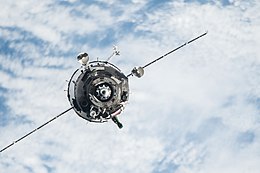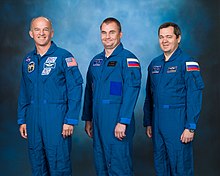cosmos.wikisort.org - Spacecraft
Soyuz TMA-20M was a 2016 Russian Soyuz spaceflight to the International Space Station (ISS).[3] It transported three members of the Expedition 47 crew to the ISS. TMA-20M was the 129th flight of a Soyuz spacecraft. The crew consisted of a Russian commander and flight engineer, as well as an American flight engineer.
 Soyuz TMA-20M spacecraft approaches the ISS | |
| Operator | Roskosmos |
|---|---|
| COSPAR ID | 2016-018A |
| SATCAT no. | 41391 |
| Mission duration | 172 days 3 hours 47 minutes |
| Spacecraft properties | |
| Spacecraft type | Soyuz-TMA-M 11F747 No.720[1] |
| Manufacturer | RKK Energia |
| Crew | |
| Crew size | 3 |
| Members | Aleksey Ovchinin Oleg Skripochka Jeffrey N. Williams |
| Callsign | Burlak |
| Start of mission | |
| Launch date | March 18, 2016 21:26:38 UTC |
| Rocket | Soyuz-FG |
| Launch site | Baikonur 1/5 |
| End of mission | |
| Landing date | September 7, 2016 01:13 UTC |
| Landing site | Kazakhstan |
| Orbital parameters | |
| Reference system | Geocentric |
| Regime | Low Earth |
| Docking with ISS | |
| Docking port | Poisk zenith |
| Docking date | March 19, 2016 03:09 UTC[2] |
| Undocking date | September 6, 2016 21:51:30 UTC |
| Time docked | 5 months, 2 weeks, 4 days, 18 hours, 42 minutes |
 (l-r) Williams, Ovchinin and Skripochka Soyuz programme (Crewed missions) | |
It was the final flight of the Soyuz TMA-M design, being replaced by the Soyuz MS in 2016.
Crew
| Position[4] | Crew Member | |
|---|---|---|
| Commander | Expedition 47 First spaceflight | |
| Flight Engineer 1 | Expedition 47 Second spaceflight | |
| Flight Engineer 2 | Expedition 47 Fourth and last spaceflight | |
Backup crew
| Position[5] | Crew Member | |
|---|---|---|
| Commander | ||
| Flight Engineer 1 | ||
| Flight Engineer 2 | ||
References
Wikimedia Commons has media related to Soyuz TMA-20M.
- "Soyuz-TMA 01M - 20M (7K-STMA, 11F747)". Gunter's Space Page. Retrieved 19 March 2016.
- "Launch, Docking Returns International Space Station Crew to Full Strength". NASA. 18 March 2016. Retrieved 19 March 2016.
- "Russian Launch Manifest". Retrieved 13 March 2014.
- Планируемые полёты (in Russian). astronaut.ru. Retrieved 13 March 2014.
- astronaut.ru (2013). "Орбитальные полёты".
На других языках
- [en] Soyuz TMA-20M
[es] Soyuz TMA-20M
Soyuz TMA-20M fue un vuelo espacial del Soyuz efectuado el 18 de marzo de 2016.[1][2]Transportó a tres miembros de la tripulación de la Expedición 47 hacia la Estación Espacial Internacional. La TMA-20M fue el vuelo número 129 de una nave espacial Soyuz. El equipo está compuesto por un comandante ruso, un ingeniero de vuelo ruso y un ingeniero de vuelo estadounidense.[ru] Союз ТМА-20М
«Союз ТМА-20М» — стартовавший 19 марта 2016 года российский космический корабль, доставивший на международную космическую станцию трёх участников экспедиции МКС-47/48. Это 127-й пилотируемый полёт корабля «Союз», первый полёт которого состоялся в 1967 году.Текст в блоке "Читать" взят с сайта "Википедия" и доступен по лицензии Creative Commons Attribution-ShareAlike; в отдельных случаях могут действовать дополнительные условия.
Другой контент может иметь иную лицензию. Перед использованием материалов сайта WikiSort.org внимательно изучите правила лицензирования конкретных элементов наполнения сайта.
Другой контент может иметь иную лицензию. Перед использованием материалов сайта WikiSort.org внимательно изучите правила лицензирования конкретных элементов наполнения сайта.
2019-2025
WikiSort.org - проект по пересортировке и дополнению контента Википедии
WikiSort.org - проект по пересортировке и дополнению контента Википедии


